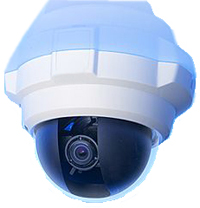ONVIF Video Surveillance with Xeoma

ONVIF in Xeoma simplifies camera connection and management, ensuring compatibility, automatic detection, PTZ control, and access to advanced features.
What is ONVIF?
ONVIF is an international standard for network video surveillance that ensures compatibility between devices (IP cameras, video recorders, etc.) from different manufacturers. This simplifies the creation of video surveillance systems, enabling seamless equipment integration.
Benefits of ONVIF
Using ONVIF with the Xeoma software unlocks several possibilities:
- Automatic camera detection on the network.
- PTZ function control (pan, tilt, zoom).
- Camera settings adjustment (brightness, contrast, etc.).
- Time synchronization of the camera with the server.
- Sending commands to the camera and its outputs.
- Using built-in camera detectors.
- Exclusive Xeoma features, such as PTZ tracking and importing recordings from an SD card.
How to Connect an ONVIF Camera?
Connecting a camera with ONVIF support is automatic. Follow these steps:
- Launch the Xeoma software.
- Click the “+” (plus) icon in the bottom panel.
- Select the “Simple local camera search” option.
Note: ONVIF support is available even in the Free Edition of Xeoma.
Controlling PTZ Cameras via ONVIF
To manage Pan-Tilt-Zoom (PTZ) cameras in Xeoma using ONVIF:
- Add the camera to the software.
- Open the camera in full-screen mode by clicking its preview.
- A PTZ control icon will appear in the bottom-right corner of the camera preview.
- Use the interface to pan, tilt, or zoom.
Additional: The Pro Edition offers PTZ presets and patrol tours. Learn more: PTZ in Xeoma.
Adjusting Camera Settings
With ONVIF, you can modify camera settings directly in Xeoma:
- Select the camera in the software interface.
- Open the “Universal Camera” module settings.
- Adjust available parameters: brightness, contrast, sharpness, etc.
- If needed, update the IP address, login, or password.
Note: Available options depend on the camera’s capabilities.
Camera Time Synchronization
To calibrate the camera’s time with the server:
- Open the all cameras view in Xeoma.
- Click the View Menu in the bottom panel (the rightmost icon).
- Select the “Synchronize time on ONVIF cameras” option.
- Choose the desired synchronization type.
Warning: Changes are irreversible without manually resetting the camera’s time.
Sending Commands to the Camera via Xeoma
To control camera functions (e.g., wiper activation):
- Add the “Camera Embedded Detector” module (available in Standard and Pro Editions).
- Configure commands via ONVIF.
- Send the desired command (e.g., activate a sensor).
Learn more: “Camera Embedded Detector” Module.
Using Built-in Camera Detectors
If the camera has built-in video analytics, use them with Xeoma:
- Connect the “Camera Embedded Detector” module.
- Select the desired detectors (e.g., motion, heat).
- Configure them through the software interface.
Advantage: Reduces server load by offloading analytics to the camera.
Unique ONVIF Features
Xeoma offers exclusive features for ONVIF cameras:
- Senstar PTZ Tracking: Rotates the camera based on sensor signals. Learn more.
- SD Card Synchronization: Imports recordings from the camera to restore archives. Learn more.
Frequently Asked Questions (FAQ)
What is ONVIF and why is it needed?
ONVIF is a standard for network video surveillance device compatibility. In Xeoma, it simplifies camera connection, PTZ control, and parameter configuration.
Are all ONVIF cameras supported?
If a camera supports ONVIF, there is a 99% chance it will work with Xeoma. Compatibility depends on the specific camera model.
How to find the ONVIF port of a camera?
The ONVIF port can be found in the camera’s documentation or admin page.
How to set up PTZ functions via ONVIF?
Add a PTZ camera to Xeoma, and the control interface will appear automatically on the screen for camera management.
What if the PTZ control doesn’t appear automatically after adding a camera?
Go to the “Universal Camera” module settings and change the port in the ‘HTTP port for PTZ functions’ field.
Can ONVIF be used in the Free Edition?
Yes, ONVIF support for camera detection is available even in the Free Edition of Xeoma.
Conclusion
ONVIF makes Xeoma a versatile video surveillance solution, simplifying camera connection and expanding their capabilities. Choose devices with ONVIF support, and the software will ensure easy setup and management.
Read also: Video Surveillance with Fisheye Cameras
August 29, 2012, updated: July 7, 2025